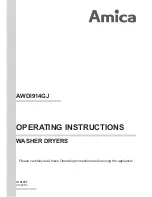
EN / 9
draining hose is connected to
the tap. Do not touch the dis-
charge water.
• Take the following precau-
tions to prevent formation of
biofilm and malodours:
– Make sure the room where
the washing machine is
placed is well ventilated.
– Wipe the door gasket and
loading door glass with a
dry and clean cloth at the
end of the programme.
• The glass of the loading door
will heat up when washing or
drying at high temperatures.
Therefore, do not allow espe-
cially children to touch the
loading door glass while
washing or drying.
1.7
Drying Safety
• Laundry that has been previ-
ously washed, cleaned, con-
taminated or stained with
gasoline/gas, dry cleaning
solvents or other inflam-
mable/explosive materials
should not be dried in the ma-
chine because they give off
inflammable or explosive va-
pours. Otherwise, fire hazard
arises.
• Laundry contaminated with
materials such as vegetable
or mineral oil, acetone, alco-
hol, gasoline, gas oil, stain re-
movers, naphtha, turpentine,
paraffin or paraffin removers
should be washed separately
in hot water by adding extra
detergent before being dried
in the washing machine with
dryer. Otherwise, fire hazard
arises.
• Do not dry textile products
that contain predominantly
foam, rubber or rubber-like
parts (e.g. shower caps, wa-
terproof textile products, rub-
ber products and clothes) or
the ones that are filled and
damaged (e.g. Pillows or
coats). There is a risk of
burns.
• If you use a laundry ball, de-
tergent scale, laundry cage or
ball in your machine, these
products may melt during dry-
ing. If you are going to
choose the drying feature, do
not use these products. Oth-
erwise, fire hazard arises.
• If you use industrial chemic-
als for cleaning, do not use
the drying function. Other-
wise, fire hazard arises.
• The door becomes very hot
after drying process. After
drying is over, open the door
of the device completely. Do
not touch the metal door loc-










































